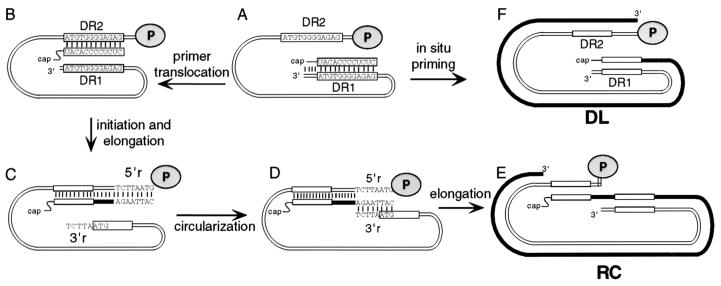FIG. 1.
Model for the synthesis of DHBV plus-strand DNA. Synthesis of plus-strand DNA begins after completion of synthesis of minus-strand DNA. (A) Full-length minus-strand DNA immediately prior to the initiation of synthesis of plus-strand DNA. Thin parallel lines represent minus-strand DNA. Gray oval (labeled P), viral P protein, which is covalently attached to the 5′ terminus of minus-strand DNA. The sequences of DR1 and DR2 are indicated within rectangles. Upon completion of synthesis of minus-strand DNA the final RNase H cleavage generates the plus-strand primer which is derived from the 5′ end of pregenomic RNA. The 3′ end of the primer contains the DR sequence. (B) Primer translocation. At least some portion of the 3′ end of the primer leaves the DR1 site and base pairs with the DR2 site. (C) Initiation of plus-strand DNA synthesis at DR2 and elongation to the 5′ end of minus-strand DNA. The minus-strand template is terminally redundant for 7 or 8 nt. 5′r and 3′r are the names of the terminal redundancies. (D) Circularization. The nascent plus-strand switches templates via complementarity between the 3′ end of the nascent plus-strand and minus-strands. (E) Elongation and completion of plus-strand DNA synthesis yields RC DNA. (F) In situ priming of plus-strand DNA synthesis generates DL DNA.

